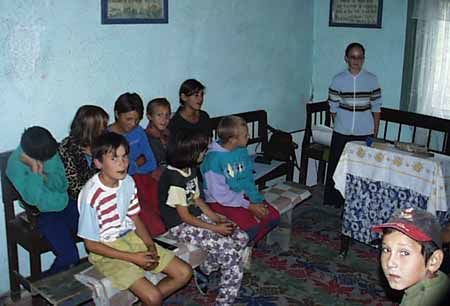Berghin
Berghin ( German blood Roth, Hungarian Berve ) is a town in Alba county in Transylvania, Romania.
Location
Berghin located in Zekesch Highlands ( Podişul Secaşelor ) in the southwest of the Transylvanian basin, in a hilly landscape, crossed by the river Garbau, a tributary of the SECA ( Zekesch ). The county capital Alba Iulia is located 13 km to the west ( straight line ).
History
On the territory of the municipality there are numerous archaeological sites. A finding place from 1961 - a burial ground about 2.5 kilometers northeast of the eingemeindeten village Ghirbom - is evidence of a settlement from the early Neolithic to the Middle Ages. Between 1978 and 1987, the remains of dwellings and tools made of ground stone were found.
Berghin was first mentioned in 1332 under the name "villa Bervini " in papal tax lists. 1348 findings of a certificate that the place belonged to the diocese of White Castle. The next written references to the location ( " Berven " ) only come back from 1554 Already at that time he had a transylvania German pastor.; the German place name " blood red ", however, is attested only in 1678. At that time the village was no longer in ecclesiastical, but noble- possession. It was not on crown land; the inhabitants were hearing. In 1784 there were surveys Transylvanian Saxon and Wallachian bondsman. In February 1849, the village was occupied by Hungarian troops of General Józef Bem revolution.
As everywhere in Transylvania left before and especially after the 1989 revolution, almost all Transylvanian Saxons the place to emigrate to Germany.
Population
The population of the greater community was as follows:
While in several incorporated villages Ghirbom ( Birnbaum ), Straja ( Hohenwarthe ) and Henig ( Henning village) since the censuses of 1850 almost exclusively live Romanians who lived in the village Berghin itself to about the 1970s, roughly equal Transylvanian Saxons and Romanians before since the mass emigration of the Saxons here almost all Romanians and Roma live. 2002, the population of the village Berghin 743 All the villages of the municipality have been made since the Second World War, a drastic population decline, which is between 60 and 70%.
Attractions
- The wooden church Sf. Petru, built in 1707 Berghin, is a listed building.
- The wooden church Sf. Nicolae, built in 1688 eingemeindeten place Ghirbom and rebuilt in the 19th century, is a historical monument.










